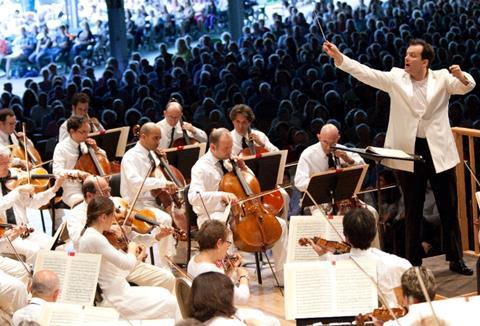In one of two companion pieces to a feature published in our April 2021 issue, former Boston Symphony Orchestra violinist Gerald Elias reveals the secrets of maintaining a good sitting posture while playing

Many years ago a freshman university violin student came for a lesson complaining of severe neck, shoulder, and back pain. It surprised both of us because her playing habits and fundamental mechanics were all sound, and from week to week she hadn’t seemed to be doing anything differently. So we examined every aspect of her playing, asking probing questions worthy of Sherlock Holmes to narrow down the cause of the problem. She wasn’t clutching her bow too tightly or raising her left shoulder to hold the violin fast, two common causes of tension and pain.
Finally, we hit on it. Until arriving at the university, this student had minimal orchestra experience, and now she was having two- to three-hour rehearsals almost every day. That in itself was not the problem, however, because the total number of hours per day she was playing remained more or less constant. The problem, to put it succinctly, was that she was sitting improperly.
How to sit is something so basic that one would imagine it could be taken for granted, like brushing your teeth in the morning. What could go wrong?
Many young violinists are taught that the proper playing posture is to look at their left hand when they play. (Disclaimer: I do not teach this, as I believe most people generally have a reasonably good idea where their left hand is even with their eyes closed.) Looking at one’s hand may be okay when playing all by oneself, though even then I don’t approve. Why? Test yourself: look straight ahead and relax your shoulders. It’s naturally comfy, right? Now, gradually turn your head to the left. The more you turn, the tighter your neck muscles become. If you stay in that position for several hours a day you’re asking for trouble; the tension will migrate from your neck to your shoulders to your arm to your hand.
If this had been your training, though, when sitting onstage you’d need to keep one eye on your left hand, one eye on the music, and one eye on the conductor. Since few of us have three eyes, many orchestral violinists compensate by holding the violin directly in front of them so their left hand is aligned with the music and the conductor. Problem solved? Think again. Try this test: lift your left hand up from your side; now start rotating it to the right. Pretty soon you’ll feel the tension in your upper arm and shoulder. Not good.
What’s the solution, then? Simple. Don’t bother to look at your left hand. (Some of the more cynical among us might say, ’Don’t bother to look at the conductor.’ Naughty.) Use your ears, not your eyes, to decide where your fingers should go. Music is about listening, not seeing. Sit directly in front of the music, line it up with the conductor and have confidence that your fingers will go in the right place.
I just threw you a curveball. Did you catch it? Because there are two violinists per desk, you can’t sit directly in front of the music unless you’re willing to risk being strangled by your desk partner. Each of you has to compromise and sit somewhat angled toward the music. What is crucial here is to make sure that it’s your chair, not your body, that is angled; otherwise, you end up twisted like a pretzel, sitting facing one direction and looking in another. A sure way to end up at the chiropractor.
Read: Tales of an orchestral violinist – imperceptible page turning
Read: Orchestral Tricks: in plain sight
Read: 10 tips for a successful orchestral audition
Usually this compromise works out. Sometimes, if, for example, your desk partner no longer has keen eyesight or moves around with unbounded enthusiasm, you may be forced to move farther away than is comfortable. There have been times that I’ve ended up with the trombone section in my sightline instead of the conductor. Hopefully, those times are infrequent, because in addition to back pain one can become susceptible to severe ulcer and thoughts of homicide.
So much for positioning. After experimenting at our lesson, my seated student is already feeling better, facing the music (literally, not figuratively), and with me as the mock conductor in her direct line of sight.
But, as the late-night TV ads say: ’But wait, there’s more!’ Positioning is one thing. How you sit is another. I notice that my conscientious, diligent student is sitting on the front edge of the chair, her back straight, almost arched in fact. That’s how she was taught by her well-meaning high school orchestra conductor. It’s a sight the parents love: all those talented young kids uniformly sitting at attention, like proud Marines in formation. The problem is, sitting like this can really be bad for your back. Just try that for two hours, and add to that holding your arms up as if you have a violin in your hands. I bet you won’t last ten minutes.
The solution is to make the chair your friend. Sit all the way back, (not slouching), with your back and posterior against the back of the chair. Let it help to support you. If, from time to time, you need to stretch, I learned one simple and effective way from my former teacher and Boston Symphony colleague, the legendary concertmaster Joseph Silverstein; and that is to press down on the floor with your feet and push the front legs of the chair off the ground an inch or two for a few seconds at a time. Another suggestion he made was to practice with a reasonably thin paperback under each front leg of the chair to facilitate resting against the chair back. I would not recommend Moby-Dick for this. You might end up staring uncomprehendingly at the ceiling.
Musicians are also different sizes and shapes, though that fact is disguised by the same black-and-white outfits they wear onstage. It stands to reason that different-shaped bodies require different chairs to get the same therapeutic result. In orchestras like the Boston Symphony, many musicians have their own adjustable or custom-made chairs. It might not make the stagehands very happy, but it saves a lot on physical therapy bills.
My student is already much more comfortable. There’s a smile on her face. One last consideration: how do you hold your violin when you’re not playing? Most school orchestra students are taught to hold the violin like the dour farmer with his pitchfork in American Gothic. Out in front, straight up and down, with the fiddle resting on your knee. Most of the time that’s probably okay, but one time when I was having my own shoulder issues, I discovered that whenever I had a rest in the music, if I placed my instrument on my lap and just let my left arm dangle freely the pain disappeared in moments.
So there you go. All my trade secrets. Now, whenever a student arrives for a lesson and says, ’Mr Elias, my shoulder’s killing me,’ my initial response is, ’Have a seat, please.’
An earlier version of this article was published in 2020 by the Boston Symphony Orchestra, with whose kind permission it appears here.
This article is published as a companion piece to Gerald Elias’s feature in The Strad’s March 2021 issue on some of the universal challenges faced by orchestral string players. To read about onstage seating changes, protecting players’ hearing and playing outside click here to subscribe and login. The March 2021 digital magazine and print edition are on sale now.
-
This article was published in the March 2021 Francesca Dego issue
The Italian violinist is granted the rare opportunity to record on Paganini’s ‘Il Cannone’ Guarneri ’del Gesù’. Explore all the articles in this issue. Explore all the articles in this issue
More from this issue…
- Francesca Dego plays ‘Il Cannone’
- Ivry Gitlis 1922-2020
- Modern-day violin making dynasties
- Astor Piazzolla - 100 years
- Violin making in China
- The trials of orchestral playing
Read more playing content here












































No comments yet